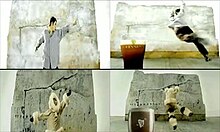-
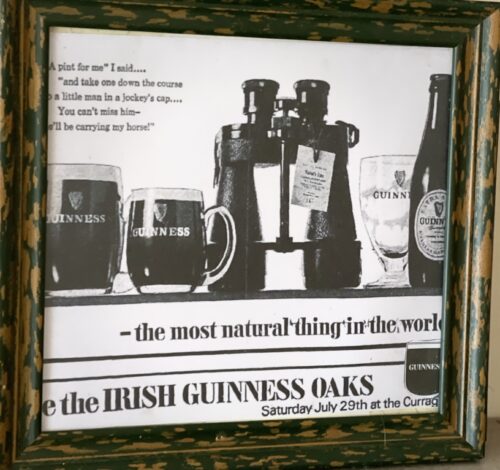
 38cm x 40cm Imagination is something Guinness Advertising has never been short of… From John Gilroy’s hapless zookeeper and his menagerie of creatures to a Polynesian surfer and a herd of white horses; from messages in bottles setting sail across the ocean to a single, heart-stoppingly enormous wave. Guinness have been carving out their own creative path for almost a century with decades of extraordinary and enduring print, TV and digital campaigns to their name, and hopefully they will continue to push boundaries to tell stories to the world. Here’s to original thinking !
38cm x 40cm Imagination is something Guinness Advertising has never been short of… From John Gilroy’s hapless zookeeper and his menagerie of creatures to a Polynesian surfer and a herd of white horses; from messages in bottles setting sail across the ocean to a single, heart-stoppingly enormous wave. Guinness have been carving out their own creative path for almost a century with decades of extraordinary and enduring print, TV and digital campaigns to their name, and hopefully they will continue to push boundaries to tell stories to the world. Here’s to original thinking ! -

 Old Bushmills Irish Whiskey advert- depicting the Cheshire Hunt .Officially the worlds oldest whiskey distillery- when in 1608 King James I granted Sir Thomas Phillips,landowner and Governor of Co Antrim,Ireland - a licence to distill.It was in 1784 when Mr Hugh Anderson registered the Old Bushmills Distillery and the Pot Still became its registered trademark, which is still a mark of genuine distinction to this day. 50cm x 65cm Belfast The Bushmills area has a long tradition with distillation. According to one story, as far back as 1276, an early settler called Sir Robert Savage of Ards, before defeating the Irish in battle, fortified his troops with "a mighty drop of acqua vitae". In 1608, a licence was granted to Sir Thomas Phillips (Irish adventurer) by King James I to distil whiskey. The Bushmills Old Distillery Company itself was not established until 1784 by Hugh Anderson. Bushmills suffered many lean years with numerous periods of closure with no record of the distillery being in operation in the official records both in 1802 and in 1822. In 1860 a Belfast spirit merchant named Jame McColgan and Patrick Corrigan bought the distillery; in 1880 they formed a limited company. In 1885, the original Bushmills buildings were destroyed by fire but the distillery was swiftly rebuilt. In 1890, a steamship owned and operated by the distillery, SS Bushmills, made its maiden voyage across the Atlantic to deliver Bushmills whiskey to America. It called at Philadelphiaand New York City before heading on to Singapore, Hong Kong, Shanghai and Yokohama.In the early 20th century, the U.S. was a very important market for Bushmills (and other Irish Whiskey producers). American Prohibition in 1920 came as a large blow to the Irish Whiskey industry, but Bushmills managed to survive. Wilson Boyd, Bushmills' director at the time, predicted the end of prohibition and had large stores of whiskey ready to export. After the Second World War, the distillery was bought by Isaac Wolfson, and, in 1972, it was taken over by Irish Distillers, meaning that Irish Distillers controlled the production of all Irish whiskey at the time. In June 1988, Irish Distillers was bought by French liquor group Pernod Ricard.In June 2005, the distillery was bought by Diageo for £200 million. Diageo have also announced a large advertising campaign in order to regain a market share for Bushmills.In May 2008, the Bank of Ireland issued a new series of sterling banknotes in Northern Ireland which all feature an illustration of the Old Bushmills Distillery on the obverse side, replacing the previous notes series which depicted Queen's University of Belfast. In November 2014 it was announced that Diageo had traded the Bushmills brand with Jose Cuervo in exchange for the 50% of the Don Julio brand of tequila that Diageo did not already own.
Old Bushmills Irish Whiskey advert- depicting the Cheshire Hunt .Officially the worlds oldest whiskey distillery- when in 1608 King James I granted Sir Thomas Phillips,landowner and Governor of Co Antrim,Ireland - a licence to distill.It was in 1784 when Mr Hugh Anderson registered the Old Bushmills Distillery and the Pot Still became its registered trademark, which is still a mark of genuine distinction to this day. 50cm x 65cm Belfast The Bushmills area has a long tradition with distillation. According to one story, as far back as 1276, an early settler called Sir Robert Savage of Ards, before defeating the Irish in battle, fortified his troops with "a mighty drop of acqua vitae". In 1608, a licence was granted to Sir Thomas Phillips (Irish adventurer) by King James I to distil whiskey. The Bushmills Old Distillery Company itself was not established until 1784 by Hugh Anderson. Bushmills suffered many lean years with numerous periods of closure with no record of the distillery being in operation in the official records both in 1802 and in 1822. In 1860 a Belfast spirit merchant named Jame McColgan and Patrick Corrigan bought the distillery; in 1880 they formed a limited company. In 1885, the original Bushmills buildings were destroyed by fire but the distillery was swiftly rebuilt. In 1890, a steamship owned and operated by the distillery, SS Bushmills, made its maiden voyage across the Atlantic to deliver Bushmills whiskey to America. It called at Philadelphiaand New York City before heading on to Singapore, Hong Kong, Shanghai and Yokohama.In the early 20th century, the U.S. was a very important market for Bushmills (and other Irish Whiskey producers). American Prohibition in 1920 came as a large blow to the Irish Whiskey industry, but Bushmills managed to survive. Wilson Boyd, Bushmills' director at the time, predicted the end of prohibition and had large stores of whiskey ready to export. After the Second World War, the distillery was bought by Isaac Wolfson, and, in 1972, it was taken over by Irish Distillers, meaning that Irish Distillers controlled the production of all Irish whiskey at the time. In June 1988, Irish Distillers was bought by French liquor group Pernod Ricard.In June 2005, the distillery was bought by Diageo for £200 million. Diageo have also announced a large advertising campaign in order to regain a market share for Bushmills.In May 2008, the Bank of Ireland issued a new series of sterling banknotes in Northern Ireland which all feature an illustration of the Old Bushmills Distillery on the obverse side, replacing the previous notes series which depicted Queen's University of Belfast. In November 2014 it was announced that Diageo had traded the Bushmills brand with Jose Cuervo in exchange for the 50% of the Don Julio brand of tequila that Diageo did not already own.- Bushmills Original – Irish whiskey blend sometimes called White Bush or Bushmills White Label. The grain whiskey is matured in American oak casks.
- Black Bush – A blend with a significantly greater proportion of malt whiskey than the white label. It features malt whiskey aged in casks previously used for Spanish Oloroso sherry.
- Red Bush – Like the Black Bush, this is a blend with a higher proportion of malt whiskey than the standard bottling, but in contrast the malt whiskey has been matured in ex-bourbon casks.
- Bushmills 10 year single malt – Combines malt whiskeys aged at least 10 years in American bourbon or Oloroso sherry casks.
- Bushmills Distillery Reserve 12 year single malt – exclusively available at the Old Bushmills Distillery, this 12 year aged single malt is matured in oak casks for a rich, complex flavour with notes of sherry, dark chocolate and spices.
- Bushmills 16 year single malt – Malt whiskeys aged at least 16 years in American bourbon barrels or Spanish Oloroso sherry butts are mixed together before finishing in Port pipes for a few months.
- Bushmills 21 year single malt – A limited number of 21 year bottles are made each year. After 19 years, bourbon-barrel-aged and sherry-cask-aged malt whiskeys are combined, which is followed by two years of finishing in Madeira drums.
- Bushmills 1608: Originally released as a special 400th Anniversary whiskey; since 2009 it will be available only in the Whiskey Shop at the distillery and at duty-free shops.
-

 34cm x 22cmThis Flying Column operated across the West Mayo area during the War of Independence. The photograph was taken shortly after the Carrowkennedy ambush on a RIC Barracks; the men are displaying the captured weapons. On the 2nd June 1921 the West Mayo Flying Column ambushed British soldiers on the Westport to Leenane road. After the ambush they went on the run. While near Laherdane in the vicinity of Neiphin Mountain they were visited by Jack Leonard. Leonard was a photographer and a cousin of Michael Kilroy, who was the Officer in Command of the brigade and took the only photograph of the Flying Column that exists.
34cm x 22cmThis Flying Column operated across the West Mayo area during the War of Independence. The photograph was taken shortly after the Carrowkennedy ambush on a RIC Barracks; the men are displaying the captured weapons. On the 2nd June 1921 the West Mayo Flying Column ambushed British soldiers on the Westport to Leenane road. After the ambush they went on the run. While near Laherdane in the vicinity of Neiphin Mountain they were visited by Jack Leonard. Leonard was a photographer and a cousin of Michael Kilroy, who was the Officer in Command of the brigade and took the only photograph of the Flying Column that exists.
-
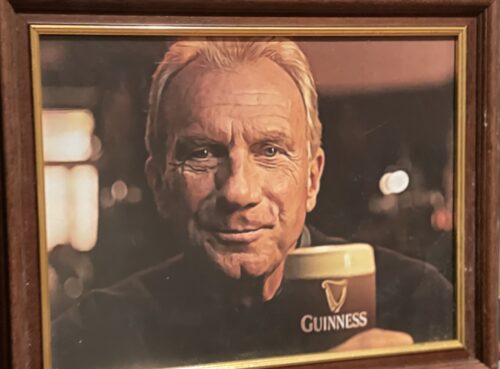
 The television commercial created by the famous brewing company will leave you with a smile on your face and maybe a craving for a pint of the black stuff! Former Fighting Irish quarterback Joe Montana features in this Guinness US commercial from 2021, while a cover of the catchy 1999 song "Praise You" plays in the background. On a trip with my family to Ireland, I fell in love with Guinness. A perfect pint is lighter and more delicious than I ever imagined," Montana previously said in an interview. Guinness US is currently running a seven-year collaboration with Notre Dame Fighting Irish, uniting two Irish institutions, and raising a Guinness toast to honor the Irish faithful – whether you're Irish by blood or in spirit. The brewing company is also the official beer of Notre Dame Fighting Irish and fans can enjoy this weekend game and relive their favorite football memories with the special edition Notre Dame 8-packs of Guinness Draught cans, which can be found across select U.S. markets, including Indiana, New York, Chicago and Boston.
The television commercial created by the famous brewing company will leave you with a smile on your face and maybe a craving for a pint of the black stuff! Former Fighting Irish quarterback Joe Montana features in this Guinness US commercial from 2021, while a cover of the catchy 1999 song "Praise You" plays in the background. On a trip with my family to Ireland, I fell in love with Guinness. A perfect pint is lighter and more delicious than I ever imagined," Montana previously said in an interview. Guinness US is currently running a seven-year collaboration with Notre Dame Fighting Irish, uniting two Irish institutions, and raising a Guinness toast to honor the Irish faithful – whether you're Irish by blood or in spirit. The brewing company is also the official beer of Notre Dame Fighting Irish and fans can enjoy this weekend game and relive their favorite football memories with the special edition Notre Dame 8-packs of Guinness Draught cans, which can be found across select U.S. markets, including Indiana, New York, Chicago and Boston. -
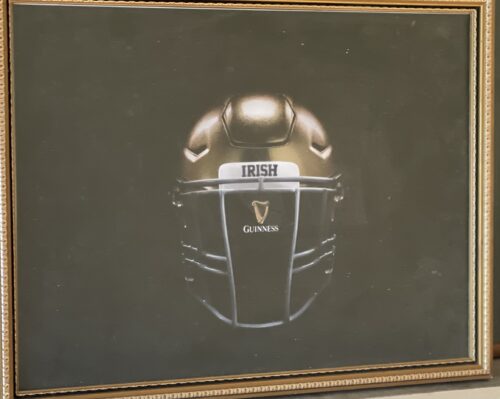
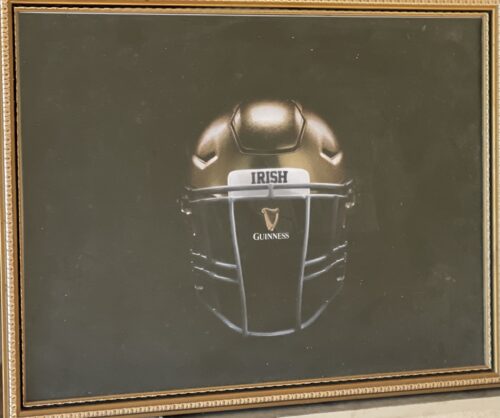 The television commercial created by the famous brewing company will leave you with a smile on your face and maybe a craving for a pint of the black stuff! Former Fighting Irish quarterback Joe Montana features in this Guinness US commercial from 2021, while a cover of the catchy 1999 song "Praise You" plays in the background. On a trip with my family to Ireland, I fell in love with Guinness. A perfect pint is lighter and more delicious than I ever imagined," Montana previously said in an interview. Guinness US is currently running a seven-year collaboration with Notre Dame Fighting Irish, uniting two Irish institutions, and raising a Guinness toast to honor the Irish faithful – whether you're Irish by blood or in spirit. The brewing company is also the official beer of Notre Dame Fighting Irish and fans can enjoy this weekend game and relive their favorite football memories with the special edition Notre Dame 8-packs of Guinness Draught cans, which can be found across select U.S. markets, including Indiana, New York, Chicago and Boston.
The television commercial created by the famous brewing company will leave you with a smile on your face and maybe a craving for a pint of the black stuff! Former Fighting Irish quarterback Joe Montana features in this Guinness US commercial from 2021, while a cover of the catchy 1999 song "Praise You" plays in the background. On a trip with my family to Ireland, I fell in love with Guinness. A perfect pint is lighter and more delicious than I ever imagined," Montana previously said in an interview. Guinness US is currently running a seven-year collaboration with Notre Dame Fighting Irish, uniting two Irish institutions, and raising a Guinness toast to honor the Irish faithful – whether you're Irish by blood or in spirit. The brewing company is also the official beer of Notre Dame Fighting Irish and fans can enjoy this weekend game and relive their favorite football memories with the special edition Notre Dame 8-packs of Guinness Draught cans, which can be found across select U.S. markets, including Indiana, New York, Chicago and Boston. -

 32cm x 28cm Originating from an pub in Co Kerry -this innuendo laden election poster will catch the eye in any bar ! Richard Nixon’s mother Hannah was descended from the Milhous family, Irish Quakers from Timahoe, Kildare while the first Nixon to arrive in the US, James, left Ireland in 1731. President Nixon visited the small town in October 1970 during a state visit to Ireland. He is the only US president to date to resign from office following his involvement in the Watergate scandal.
32cm x 28cm Originating from an pub in Co Kerry -this innuendo laden election poster will catch the eye in any bar ! Richard Nixon’s mother Hannah was descended from the Milhous family, Irish Quakers from Timahoe, Kildare while the first Nixon to arrive in the US, James, left Ireland in 1731. President Nixon visited the small town in October 1970 during a state visit to Ireland. He is the only US president to date to resign from office following his involvement in the Watergate scandal. -
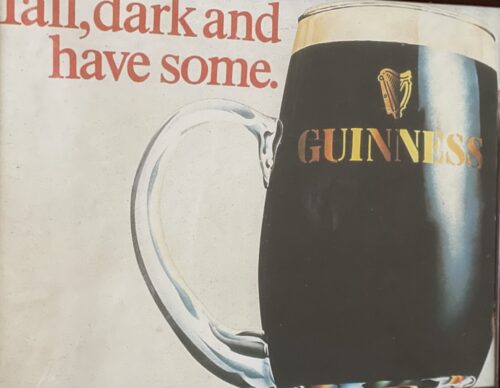
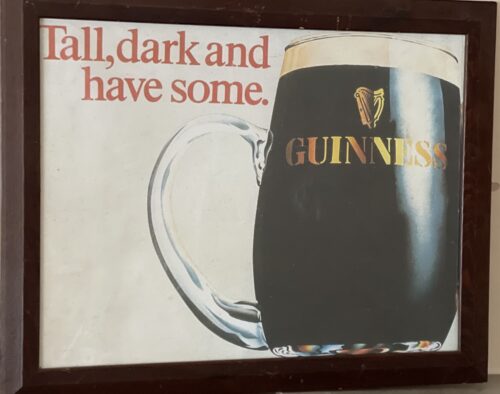 50cm x 65cm Imagination is something Guinness Advertising has never been short of… From John Gilroy’s hapless zookeeper and his menagerie of creatures to a Polynesian surfer and a herd of white horses; from messages in bottles setting sail across the ocean to a single, heart-stoppingly enormous wave. Guinness have been carving out their own creative path for almost a century with decades of extraordinary and enduring print, TV and digital campaigns to their name, and hopefully they will continue to push boundaries to tell stories to the world. Here’s to original thinking !
50cm x 65cm Imagination is something Guinness Advertising has never been short of… From John Gilroy’s hapless zookeeper and his menagerie of creatures to a Polynesian surfer and a herd of white horses; from messages in bottles setting sail across the ocean to a single, heart-stoppingly enormous wave. Guinness have been carving out their own creative path for almost a century with decades of extraordinary and enduring print, TV and digital campaigns to their name, and hopefully they will continue to push boundaries to tell stories to the world. Here’s to original thinking ! -

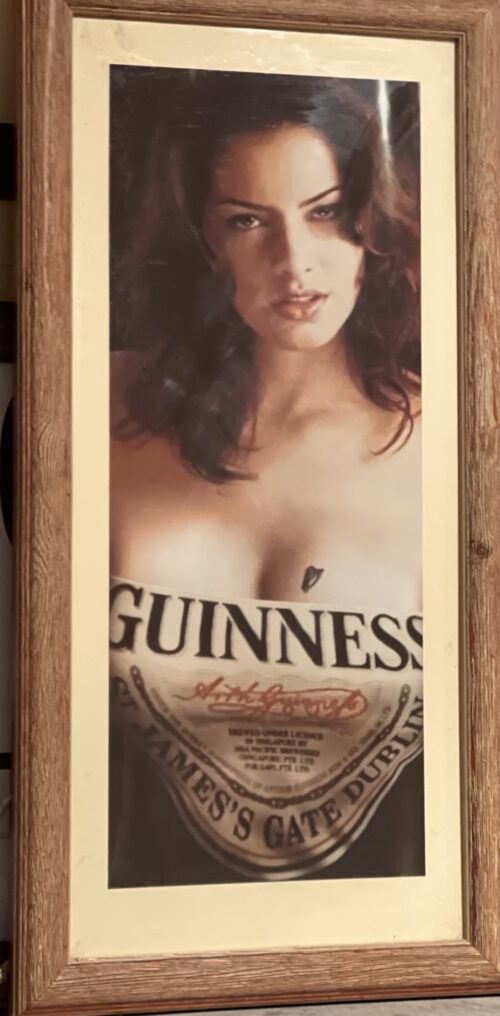 74cm x 38cm Imagination is something Guinness Advertising has never been short of… From John Gilroy’s hapless zookeeper and his menagerie of creatures to a Polynesian surfer and a herd of white horses; from messages in bottles setting sail across the ocean to a single, heart-stoppingly enormous wave. Guinness have been carving out their own creative path for almost a century with decades of extraordinary and enduring print, TV and digital campaigns to their name, and hopefully they will continue to push boundaries to tell stories to the world. Here’s to original thinking !
74cm x 38cm Imagination is something Guinness Advertising has never been short of… From John Gilroy’s hapless zookeeper and his menagerie of creatures to a Polynesian surfer and a herd of white horses; from messages in bottles setting sail across the ocean to a single, heart-stoppingly enormous wave. Guinness have been carving out their own creative path for almost a century with decades of extraordinary and enduring print, TV and digital campaigns to their name, and hopefully they will continue to push boundaries to tell stories to the world. Here’s to original thinking ! -

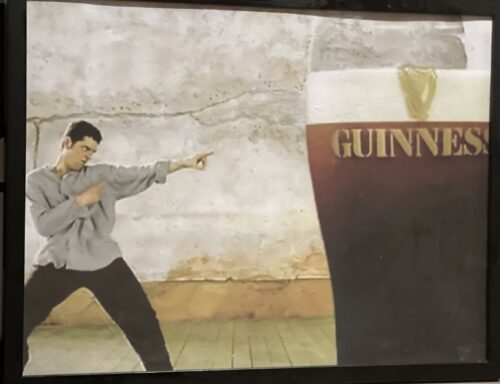 45cm x 60cm Anticipation is an Irish advertisement launched by Guinness plc in 1994 to promote Guinness-brand draught stout. The advert, which appeared in print, posters, and cinema and television spots, was conceived by Irish advertising agency Arks, and starred relatively unknown Irish actor Joe McKinney as the 'Dancing Man' and Gordon Winter as the barman. It was the final part of the "Guinness Time" advertising campaign, which had been running in Ireland since the late 1980s. The advert was credited with increasing Guinness' sales, market share and brand awareness figures. However, controversy arose following claims of plagiarism raised by British director Mehdi Norowzian, who launched an unsuccessful lawsuit in 1998 seeking remuneration for the use of techniques and style from his 1992 short film Joy.
45cm x 60cm Anticipation is an Irish advertisement launched by Guinness plc in 1994 to promote Guinness-brand draught stout. The advert, which appeared in print, posters, and cinema and television spots, was conceived by Irish advertising agency Arks, and starred relatively unknown Irish actor Joe McKinney as the 'Dancing Man' and Gordon Winter as the barman. It was the final part of the "Guinness Time" advertising campaign, which had been running in Ireland since the late 1980s. The advert was credited with increasing Guinness' sales, market share and brand awareness figures. However, controversy arose following claims of plagiarism raised by British director Mehdi Norowzian, who launched an unsuccessful lawsuit in 1998 seeking remuneration for the use of techniques and style from his 1992 short film Joy.Sequence
The low-budget ad featured only two characters: a patron of a pub and the barman serving him. The patron (McKinney) orders a pint of Guinness stout and, while waiting for the pint to be poured, carries out a series of quirky dancing movements with the settling pint in the foreground, to the amusement of the barman (Winter). The piece ends with the patron taking his first sip of the freshly poured pint overlaid by the Guinness advertising slogan "No time like Guinness Time". The advert is set to Guaglione by Pérez Prado, and makes heavy use of jump cutting from a static camera to allow the dancer to make a series of movements that could not be achieved in reality.Reception
The distinctive jump cut editing techniques of Anticipation won the commercial critical acclaim and several awards from within the advertising industry, including the 1995 Institute of Creative Advertising & Design craft award for editing as well as a Gold Medal for editing and a Golden Shark award at the Kinsale International Advertising Festival. The success of the campaign led Guinness to re-broadcast it in the United Kingdom in 1995, as a transition between the campaign "The Man With the Guinness"/"Pure Genius", which had just concluded with Chain, and its new "Black and White" campaign, still in development.Though Chain was to be the last in the Pure Genius campaign, Anticipationwas tagged with the Pure Genius slogan in the UK instead of There's No Time Like Guinness Time. As a result of its featuring in the spot, Pérez Prado's Guaglione reached the Number 1 spot in the Irish music charts,and Number 2 in the British Top 40.Lawsuit
In 1992, British director Mehdi Norowzian submitted a show reel containing a number of short examples of his work to several prospective employers, including the Irish advertising agency Arks Ltd., in the hopes of being taken on to direct one or more of their commercials. Included on the reel was a short piece entitled Joy, which was shot using a static camera on a London rooftop and comprised a jump cut sequence of a man performing an extended dance of exuberance against a plain canvas background. Arks Ltd. were contracted by Guinness to produce an advertisement to run in Ireland. Among the ideas proposed was one based on a scene from the cinematic version of Roddy Doyle's novel, The Snapper, where a man rushes into a pub to celebrate the birth of his grandson with a pint of Guinness. The artistic director at Arks, thinking of possible ways to build on the concept, recalled Norowzian's submitted reel and came up with a script and storyboard based on Joy to present to Guinness. The idea was accepted, and Arks approached Norowzian to direct the commercial. Norowzian refused, as he was unwilling to simply "commercialise" an old idea, and wanted to create something new. The agency then took on Richie Smyth as director, urging him to create something "with an atmosphere broadly similar to that portrayed in Joy". Feeling that the original storyboard was too close to Joy, a new one was prepared. The result was Anticipation. Following the broadcast of the television spot in 1994, Norowzian lodged a complaint and ultimately a lawsuit against Arks Ltd. and Guinness, claiming that Anticipation breached his copyrights and accusing the agency of passing off. The plaintiff's claim for copyright infringement were based on a passage in the Copyright, Designs and Patents Act 1988defining a dramatic work as including "recordings of a work of dance or mime", and that Anticipation was, or included, a copy of a substantial part of Joy. The case reached the High Court in 1997, where the claim of passing off was dropped. On 17 July 1998, Justice Rattee rendered his judgment that the jump cutting techniques used in Joy produced something qualitatively different from a recording of a dance or mime routine and that, as such, Joy was not in itself a dramatic work. It was therefore defined as an entrepreneurial work, a status which confers protection over only the physical recording of a work rather than the work itself. He also ruled that Anticipation did not reproduce either the whole or part of Joy. The decision was appealed, but while the Court of Appeal unanimously held that the content of a film (including the use of film and editing techniques) could enjoy copyright protection as a dramatic work, the presiding Justices ruled that Anticipation did not significantly copy any portion of Joy and dismissed the case. Ultimately, Norowzian was ordered to pay £200,000 in legal costs.As a result of the case, the Institute of Contemporary Arts called for reform of copyright law in the United Kingdom.Legacy
Actor Joe McKinney spent 1994–6 making personal appearances around Europe publicising Guinness. The lifestyle became too hectic and he gave up alcohol in 1997.He found it difficult to secure other roles due to typecasting as "the Guinness man", spending time in the US where the ad had not been broadcast. As one of the most recognisable Guinness advertisements of the 1990s, Anticipation has been mimicked or parodied in a number of more recent Guinness campaigns, including the Irish Waiting spot in 2004 promoting cans of Guinness draught beer,and director JJ Keith's British Eskimo commercial, which was part of an extended campaign promoting Guinness Extra Cold in summer 2004 and 2005. In March 2009, Guinness announced that Anticipation would be aired again as part of a "Classic Ads" campaign to mark the brewery's 250th anniversary. Imagination is something Guinness Advertising has never been short of… From John Gilroy’s hapless zookeeper and his menagerie of creatures to a Polynesian surfer and a herd of white horses; from messages in bottles setting sail across the ocean to a single, heart-stoppingly enormous wave. Guinness have been carving out their own creative path for almost a century with decades of extraordinary and enduring print, TV and digital campaigns to their name, and hopefully they will continue to push boundaries to tell stories to the world. Here’s to original thinking ! -
Out of stock

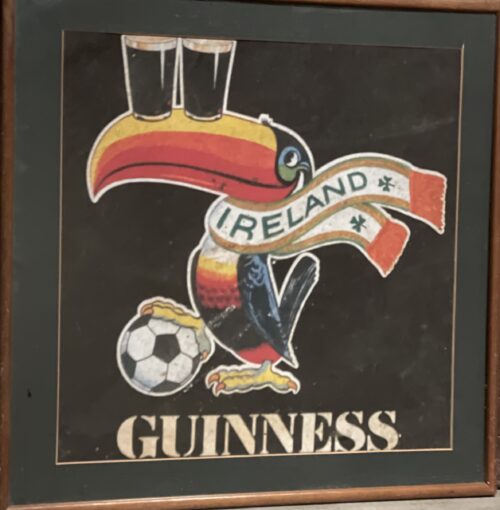 51cm x 51cm Imagination is something Guinness Advertising has never been short of… From John Gilroy’s hapless zookeeper and his menagerie of creatures to a Polynesian surfer and a herd of white horses; from messages in bottles setting sail across the ocean to a single, heart-stoppingly enormous wave. Guinness have been carving out their own creative path for almost a century with decades of extraordinary and enduring print, TV and digital campaigns to their name, and hopefully they will continue to push boundaries to tell stories to the world. Here’s to original thinking !
51cm x 51cm Imagination is something Guinness Advertising has never been short of… From John Gilroy’s hapless zookeeper and his menagerie of creatures to a Polynesian surfer and a herd of white horses; from messages in bottles setting sail across the ocean to a single, heart-stoppingly enormous wave. Guinness have been carving out their own creative path for almost a century with decades of extraordinary and enduring print, TV and digital campaigns to their name, and hopefully they will continue to push boundaries to tell stories to the world. Here’s to original thinking ! -
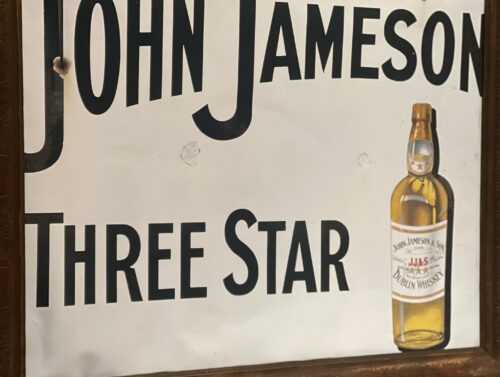
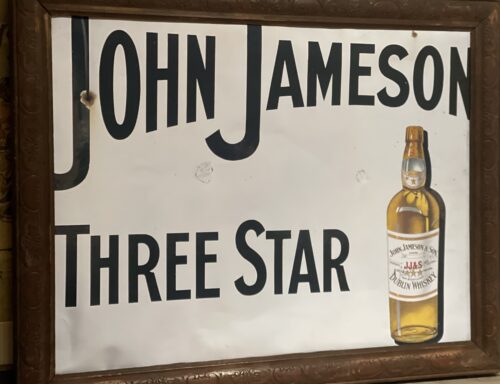 64cm x 50cm John Jameson was originally a lawyer from Alloa in Scotland before he founded his eponymous distillery in Dublin in 1780.Prevoius to this he had made the wise move of marrying Margaret Haig (1753–1815) in 1768,one of the simple reasons being Margaret was the eldest daughter of John Haig, the famous whisky distiller in Scotland. John and Margaret had eight sons and eight daughters, a family of 16 children. Portraits of the couple by Sir Henry Raeburn are on display in the National Gallery of Ireland. John Jameson joined the Convivial Lodge No. 202, of the Dublin Freemasons on the 24th June 1774 and in 1780, Irish whiskey distillation began at Bow Street. In 1805, he was joined by his son John Jameson II who took over the family business that year and for the next 41 years, John Jameson II built up the business before handing over to his son John Jameson the 3rd in 1851. In 1901, the Company was formally incorporated as John Jameson and Son Ltd. Four of John Jameson’s sons followed his footsteps in distilling in Ireland, John Jameson II (1773 – 1851) at Bow Street, William and James Jameson at Marrowbone Lane in Dublin (where they partnered their Stein relations, calling their business Jameson and Stein, before settling on William Jameson & Co.). The fourth of Jameson's sons, Andrew, who had a small distillery at Enniscorthy, Co. Wexford, was the grandfather of Guglielmo Marconi, inventor of wireless telegraphy. Marconi’s mother was Annie Jameson, Andrew’s daughter. John Jameson’s eldest son, Robert took over his father’s legal business in Alloa. The Jamesons became the most important distilling family in Ireland, despite rivalry between the Bow Street and Marrowbone Lane distilleries. By the turn of the 19th century, it was the second largest producer in Ireland and one of the largest in the world, producing 1,000,000 gallons annually. Dublin at the time was the centre of world whiskey production. It was the second most popular spirit in the world after rum and internationally Jameson had by 1805 become the world's number one whiskey. Today, Jameson is the world's third largest single-distillery whiskey. Historical events, for a time, set the company back. The temperance movement in Ireland had an enormous impact domestically but the two key events that affected Jameson were the Irish War of Independence and subsequent trade war with the British which denied Jameson the export markets of the Commonwealth, and shortly thereafter, the introduction of prohibition in the United States. While Scottish brands could easily slip across the Canada–US border, Jameson was excluded from its biggest market for many years. The introduction of column stills by the Scottish blenders in the mid-19th-century enabled increased production that the Irish, still making labour-intensive single pot still whiskey, could not compete with. There was a legal enquiry somewhere in 1908 to deal with the trade definition of whiskey. The Scottish producers won within some jurisdictions, and blends became recognised in the law of that jurisdiction as whiskey. The Irish in general, and Jameson in particular, continued with the traditional pot still production process for many years.In 1966 John Jameson merged with Cork Distillers and John Powers to form the Irish Distillers Group. In 1976, the Dublin whiskey distilleries of Jameson in Bow Street and in John's Lane were closed following the opening of a New Midleton Distillery by Irish Distillers outside Cork. The Midleton Distillery now produces much of the Irish whiskey sold in Ireland under the Jameson, Midleton, Powers, Redbreast, Spot and Paddy labels. The new facility adjoins the Old Midleton Distillery, the original home of the Paddy label, which is now home to the Jameson Experience Visitor Centre and the Irish Whiskey Academy. The Jameson brand was acquired by the French drinks conglomerate Pernod Ricard in 1988, when it bought Irish Distillers. The old Jameson Distillery in Bow Street near Smithfield in Dublin now serves as a museum which offers tours and tastings. The distillery, which is historical in nature and no longer produces whiskey on site, went through a $12.6 million renovation that was concluded in March 2016, and is now a focal part of Ireland's strategy to raise the number of whiskey tourists, which stood at 600,000 in 2017.Bow Street also now has a fully functioning Maturation Warehouse within its walls since the 2016 renovation. It is here that Jameson 18 Bow Street is finished before being bottled at Cask Strength. In 2008, The Local, an Irish pub in Minneapolis, sold 671 cases of Jameson (22 bottles a day),making it the largest server of Jameson's in the world – a title it
64cm x 50cm John Jameson was originally a lawyer from Alloa in Scotland before he founded his eponymous distillery in Dublin in 1780.Prevoius to this he had made the wise move of marrying Margaret Haig (1753–1815) in 1768,one of the simple reasons being Margaret was the eldest daughter of John Haig, the famous whisky distiller in Scotland. John and Margaret had eight sons and eight daughters, a family of 16 children. Portraits of the couple by Sir Henry Raeburn are on display in the National Gallery of Ireland. John Jameson joined the Convivial Lodge No. 202, of the Dublin Freemasons on the 24th June 1774 and in 1780, Irish whiskey distillation began at Bow Street. In 1805, he was joined by his son John Jameson II who took over the family business that year and for the next 41 years, John Jameson II built up the business before handing over to his son John Jameson the 3rd in 1851. In 1901, the Company was formally incorporated as John Jameson and Son Ltd. Four of John Jameson’s sons followed his footsteps in distilling in Ireland, John Jameson II (1773 – 1851) at Bow Street, William and James Jameson at Marrowbone Lane in Dublin (where they partnered their Stein relations, calling their business Jameson and Stein, before settling on William Jameson & Co.). The fourth of Jameson's sons, Andrew, who had a small distillery at Enniscorthy, Co. Wexford, was the grandfather of Guglielmo Marconi, inventor of wireless telegraphy. Marconi’s mother was Annie Jameson, Andrew’s daughter. John Jameson’s eldest son, Robert took over his father’s legal business in Alloa. The Jamesons became the most important distilling family in Ireland, despite rivalry between the Bow Street and Marrowbone Lane distilleries. By the turn of the 19th century, it was the second largest producer in Ireland and one of the largest in the world, producing 1,000,000 gallons annually. Dublin at the time was the centre of world whiskey production. It was the second most popular spirit in the world after rum and internationally Jameson had by 1805 become the world's number one whiskey. Today, Jameson is the world's third largest single-distillery whiskey. Historical events, for a time, set the company back. The temperance movement in Ireland had an enormous impact domestically but the two key events that affected Jameson were the Irish War of Independence and subsequent trade war with the British which denied Jameson the export markets of the Commonwealth, and shortly thereafter, the introduction of prohibition in the United States. While Scottish brands could easily slip across the Canada–US border, Jameson was excluded from its biggest market for many years. The introduction of column stills by the Scottish blenders in the mid-19th-century enabled increased production that the Irish, still making labour-intensive single pot still whiskey, could not compete with. There was a legal enquiry somewhere in 1908 to deal with the trade definition of whiskey. The Scottish producers won within some jurisdictions, and blends became recognised in the law of that jurisdiction as whiskey. The Irish in general, and Jameson in particular, continued with the traditional pot still production process for many years.In 1966 John Jameson merged with Cork Distillers and John Powers to form the Irish Distillers Group. In 1976, the Dublin whiskey distilleries of Jameson in Bow Street and in John's Lane were closed following the opening of a New Midleton Distillery by Irish Distillers outside Cork. The Midleton Distillery now produces much of the Irish whiskey sold in Ireland under the Jameson, Midleton, Powers, Redbreast, Spot and Paddy labels. The new facility adjoins the Old Midleton Distillery, the original home of the Paddy label, which is now home to the Jameson Experience Visitor Centre and the Irish Whiskey Academy. The Jameson brand was acquired by the French drinks conglomerate Pernod Ricard in 1988, when it bought Irish Distillers. The old Jameson Distillery in Bow Street near Smithfield in Dublin now serves as a museum which offers tours and tastings. The distillery, which is historical in nature and no longer produces whiskey on site, went through a $12.6 million renovation that was concluded in March 2016, and is now a focal part of Ireland's strategy to raise the number of whiskey tourists, which stood at 600,000 in 2017.Bow Street also now has a fully functioning Maturation Warehouse within its walls since the 2016 renovation. It is here that Jameson 18 Bow Street is finished before being bottled at Cask Strength. In 2008, The Local, an Irish pub in Minneapolis, sold 671 cases of Jameson (22 bottles a day),making it the largest server of Jameson's in the world – a title it


